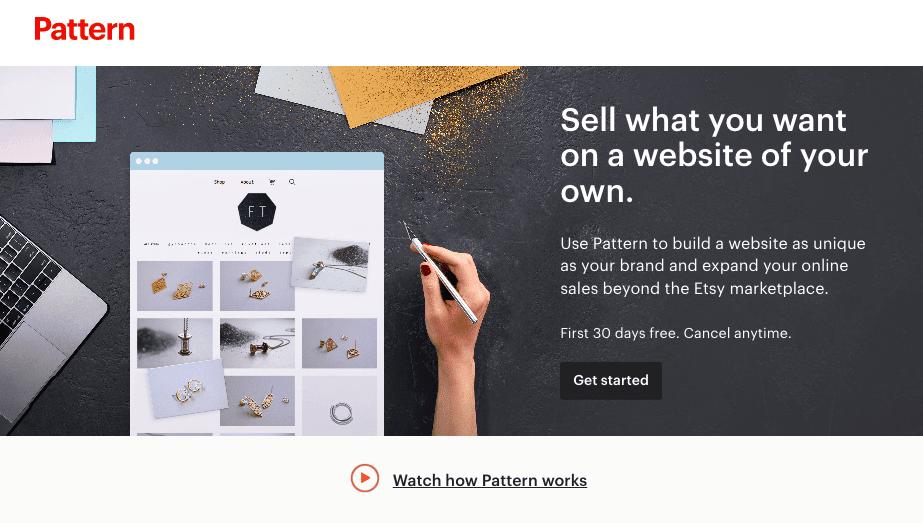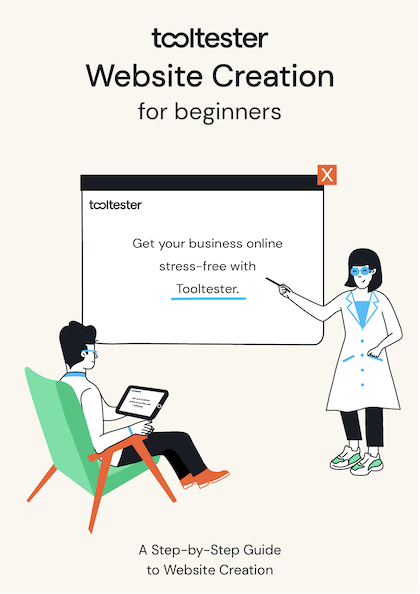Tooltester is supported by readers like yourself. We may earn an affiliate commission when you purchase through our links, which enables us to offer our research for free.
When I opened my first Etsy shop in 2009, most people’s initial question was, “What’s Etsy?” Now, Etsy hardly needs an introduction. It’s become one of the largest online marketplaces in the world with over 7.5 million active sellers, a number likely to keep growing as the popularity of creative side hustles continues to rise.
Lately, many Etsy sellers are launching their own websites to increase sales and improve brand recognition. This move has been facilitated by easy-to-use ecommerce website builders which allow entrepreneurs to create online shops without coding. Seeing this trend, Etsy now offers its own website builder, Pattern by Etsy.
In this article, I’m going to walk you through some reasons why you might want to expand your business beyond the Etsy platform. We’re going to look at how Pattern works, and I’ll go over some of its pros and cons. Finally, we’ll consider a few alternatives to Pattern for building your own website.
Before we get started, a disclosure: I love Etsy. Its advocacy for creative microbusinesses and sustainable ecommerce have made me a loyal seller. Etsy drives traffic to my shops and invests heavily in marketing. As dedicated as I am to my (three!) Etsy shops, creating my own website was a good decision, and I strongly recommend that other Etsy sellers do the same.
Why build a website?
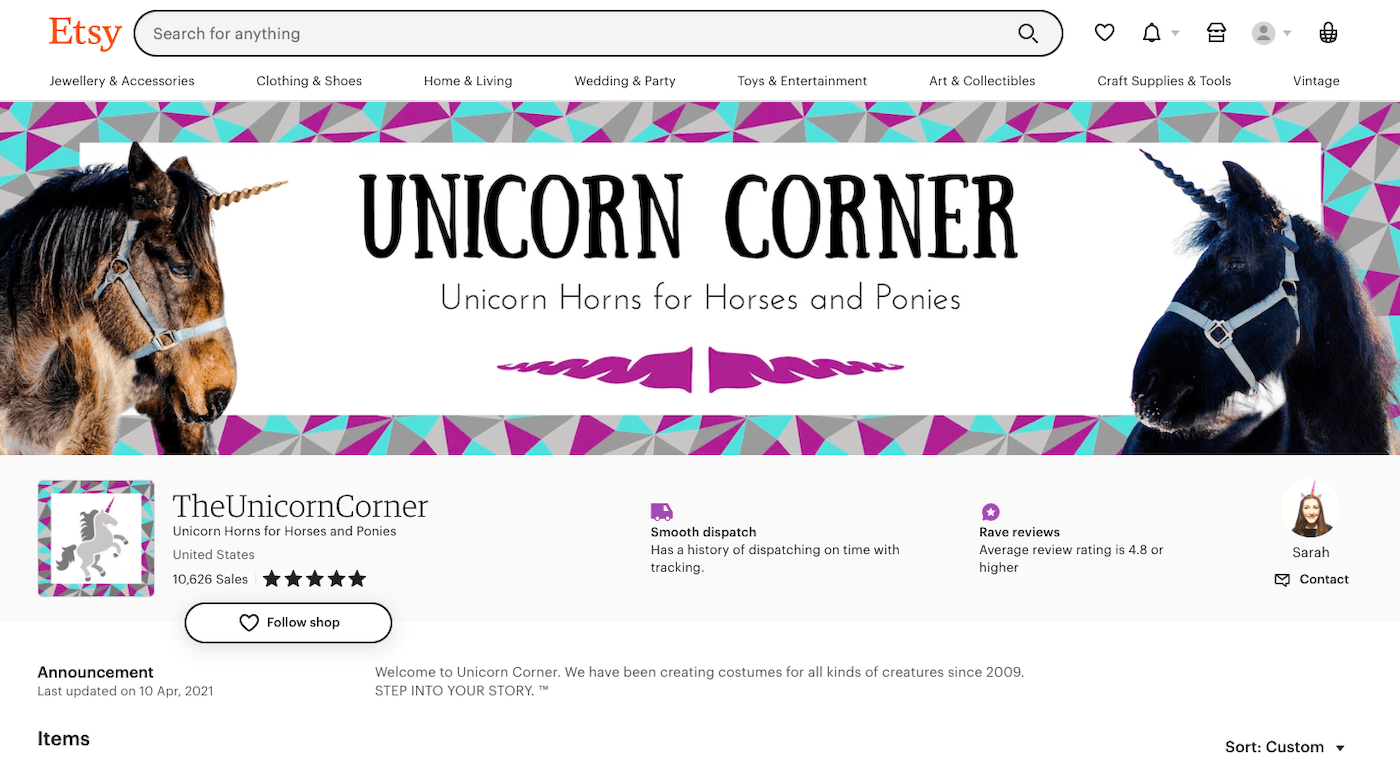
The Unicorn Corner on Etsy
I’ve spoken previously here on Tooltester about why I have both an Etsy shop and my own Shopify website. Etsy provided an easy entry into ecommerce at a time when building an online store was significantly more costly and time consuming than it is today. But as my business grew, the importance of having my own website became clear. Today, both my Etsy shop and my Shopify website are critical to my business strategy in different ways.
Here are some of the top reasons why you might not want Etsy to be your only sales channel.
Increasing Etsy fees
Etsy’s multifaceted fee structure is a bit mind boggling, and certainly not cheap. Here is an overview of the fees Etsy charges:
| Listing fee | $.20 per item |
| Transaction fee | 6.5% of sale |
| Offsite Ads fee (optional for shops selling less than $10k annually) | 12-15% of sale |
| Etsy Plus Subscription fee (optional) | $10/month |
| Payment Processing fee | Varies by location |
| Regulatory Operating fee | Varies by location |
As you can see, Etsy will take a significant cut from every sale you make on its platform. Many Etsy sellers have complained about fee increases in recent years, and even organized a strike in 2022 when transaction fees jumped up by 30%.
Etsy justifies these fees by highlighting its marketing efforts and the value its platform provides to sellers, but for some businesses these fees aren’t sustainable. By building and maintaining your own website, you have far more control over the cost and aren’t subjected to the uncertainty that comes with Etsy fee increases.
Brand identity
When shoppers make a purchase on the Etsy platform, they usually don’t remember the name of the seller’s shop because Etsy’s own branding is much more prominent. How many times have you heard, “I bought it on Etsy” rather than the name of the individual shop? To build loyalty and encourage repeat business, it’s crucial that your customers know your company name and how to find you. The best way to do this is with a standalone website, separate from your Etsy shop.
Security and Control
As a seller on Etsy, you’re obliged to comply with its policies. If Etsy’s policies don’t align with your business strategy, you might need an alternative platform. For example, in 2019 Etsy introduced its “Free Shipping Guarantee” in an attempt to compete with other major ecommerce marketplaces. Adopting Etsy’s “Free Shipping Guarantee” is optional, but sellers who don’t are not given priority placement in search results, and will see a steep reduction in sales.
By building your own website you have complete control over how you run your business. If Etsy’s policies become incompatible with your strategy, you have the security of a separate website where you can direct sales.
No matter what your sales volume is, these are compelling reasons to build your own website. So, let’s take a look at Pattern, the website builder developed by Etsy.
Etsy Pattern Review
If you’re already selling on Etsy, you’ve likely seen the option to start your own website with Pattern. With a couple of clicks, Etsy uses your existing shop data to create a website with your own URL. You can purchase a domain name through Etsy, or link one from another registrar like Namecheap.
To give you a behind-the-scenes look at how Pattern works, I set up a temporary Pattern website using my Etsy shop.
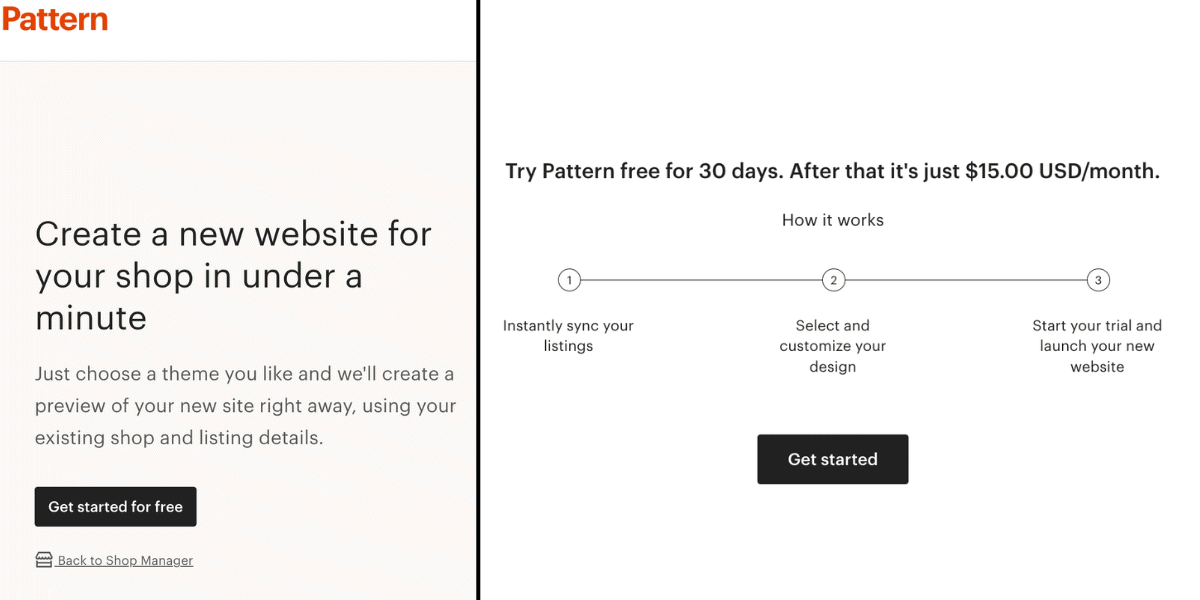
Under a minute?? The Tooltesters are skeptical.
Building a Website with Pattern
Getting started with Pattern was extremely easy. In two clicks, my listings had been imported, and I saw a preview that looked very similar to my Etsy shop. With one caveat: the aspect ratio of some of the photos was different than Etsy’s, so they looked awkwardly cropped.
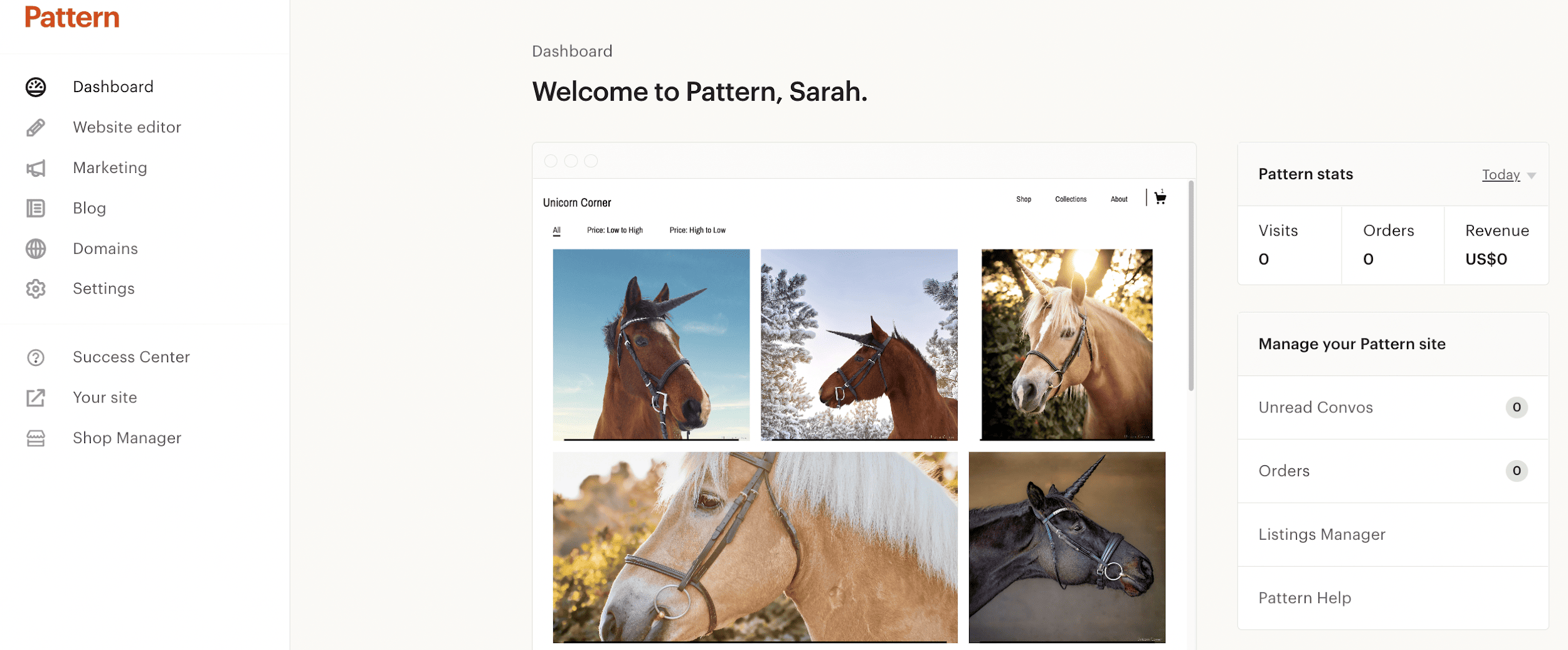
Pattern’s “Zephyr” theme uses some long, horizontal photos which don’t mesh with the size of Etsy listing photos
I used the website editor to customize the theme, and was disappointed to find that there were only 10 template options available. They were all functional, modern, and minimalistic. But each had small problems that I found frustrating. For example, the “Swatch” theme didn’t import my cover photo, but the “Pearl” theme did.
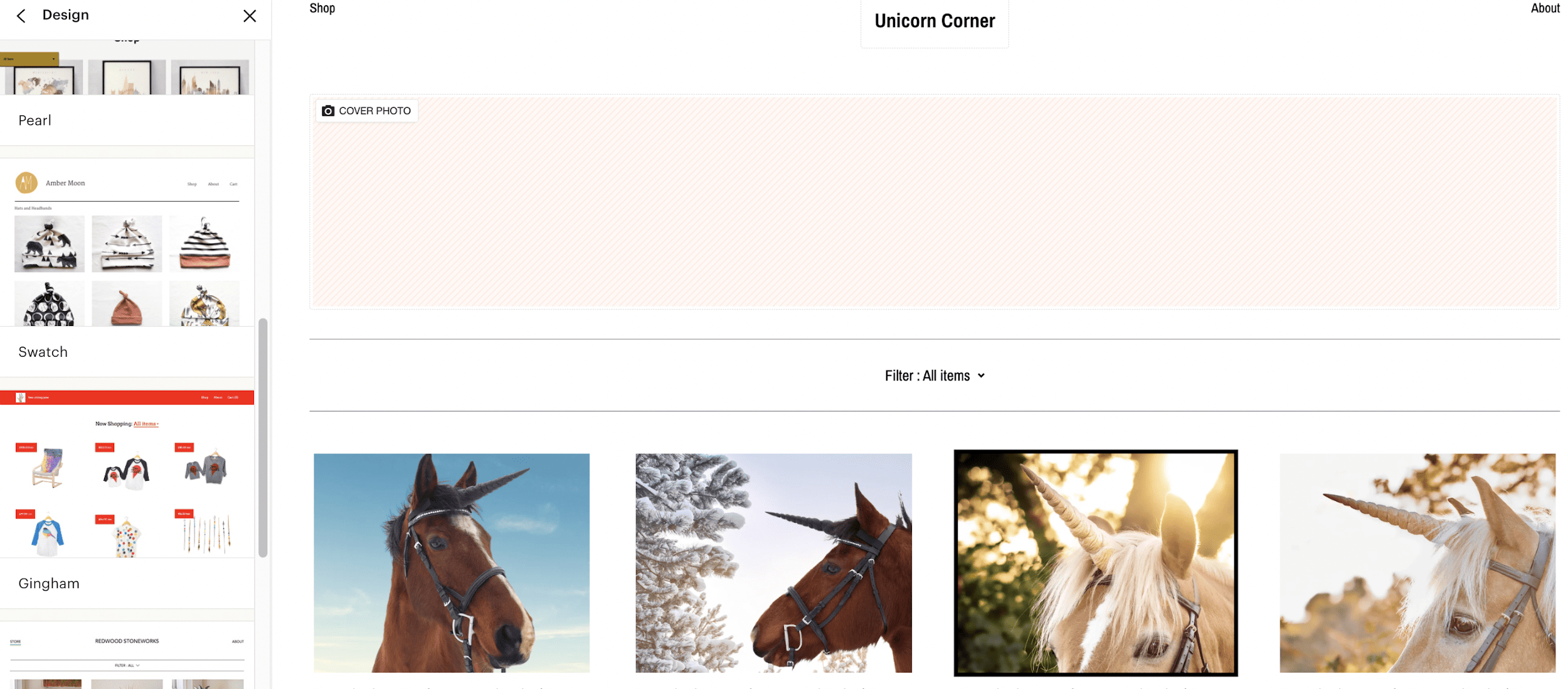
My shop elements imported inconsistently across themes.
Next, I took a look at my product listings. The photos, product descriptions, variants, and pricing was all there. But none of my product videos had imported. I invested a lot of time and money into my product videos, and they are incredibly important to convert visitors into buyers. I couldn’t believe that Pattern wouldn’t support product listing videos, so I reached out to Etsy support. Here’s what I heard:
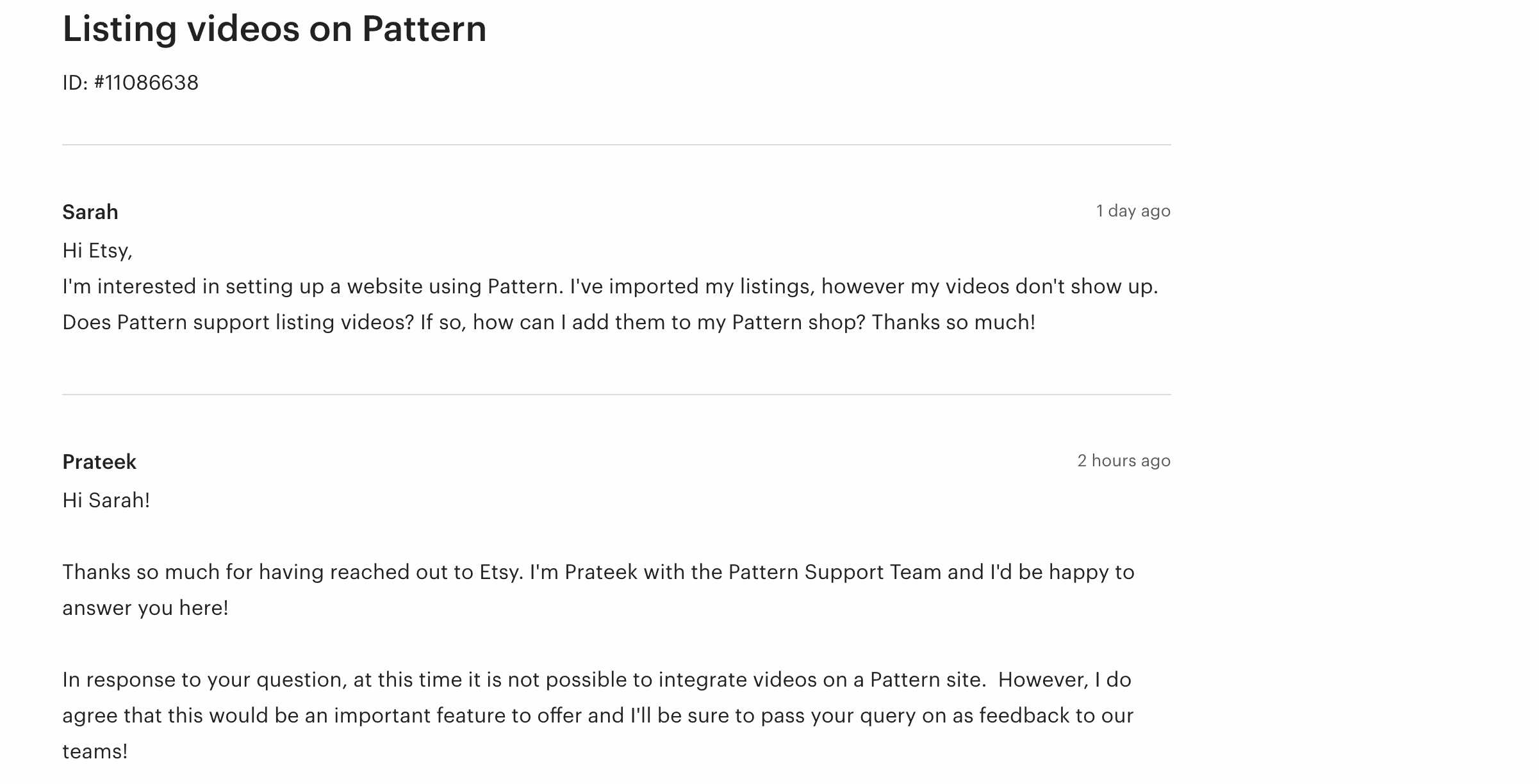
To me, this sounds like a dealbreaker. Even if you don’t currently use product videos, this is a huge drawback for Pattern. The popularity of TikTok is evidence that short-form video content is going to play an increasingly important role in ecommerce.
Keep in mind that with Pattern by Etsy, you aren’t able to add features to your website with plugins or apps. So if a function you need (like product videos) isn’t supported, there’s no workaround.
Pattern SEO
While Pattern does provide some SEO options for sellers, many of the basics are missing.
On the plus side, Pattern creates and automatically updates an XML sitemap to help search engines understand your website structure. Pattern also gives you the ability to create Pattern-specific titles and descriptions for your products. This helps avoid duplicate content which can confuse search engines.
The big drawback of Pattern SEO is that there is no way to add title tags or meta descriptions. It’s also not possible to edit the URL structure. This means that you have no control over how your page appears in search results and can’t take advantage of these critical SEO features to rank higher.
Another concern is the image alt text. When creating listings on the Etsy marketplace, sellers can add alt text to images, but this option is not available on Pattern. It’s possible that the alt text transfers with the image when it’s imported to Pattern during setup, but this isn’t entirely clear.
Pattern Pros and Cons
Let’s recap some of the pros and cons of using Pattern to build your own website.
Pattern by Etsy Pros:
- Easy to set up (but will take more than a minute!)
- $15/month is competitive with other ecommerce platforms (Etsy originally charged transaction fees on Pattern, but no longer does)
- Inventory is centrally synced in your Shop Manager dashboard, so no need to manage it separately to your Etsy store
- Options to sell internationally and add manual and automatic translations for your products
- Pattern creates and automatically updates an XML sitemap
Pattern by Etsy Cons:
- Limited customization
- Only 10 theme templates to choose from
- Shop elements don’t always import correctly
- Some themes use different aspect ratios for photos, so you would have to manually resize them
- No product videos
- No ability to add features with plugins or apps (e.g. customer reviews)
- Doesn’t receive search traffic from Etsy which makes it harder to get found
- Guest checkout not available for all orders (e.g. digital goods, orders over $250 in value)
- Basic SEO features, like title tags and meta descriptions, are missing
Alternatives to Pattern
On balance, Pattern by Etsy does not seem like the ideal website builder. Let’s take a look at a few alternatives. Two of our top picks for building your own ecommerce store are Wix and Shopify. Squarespace and WooCommerce are also good options to consider for some business owners. Here’s a quick overview of why we think they’re viable alternatives, but check out our full review articles to decide if they’re right for your business.
Wix
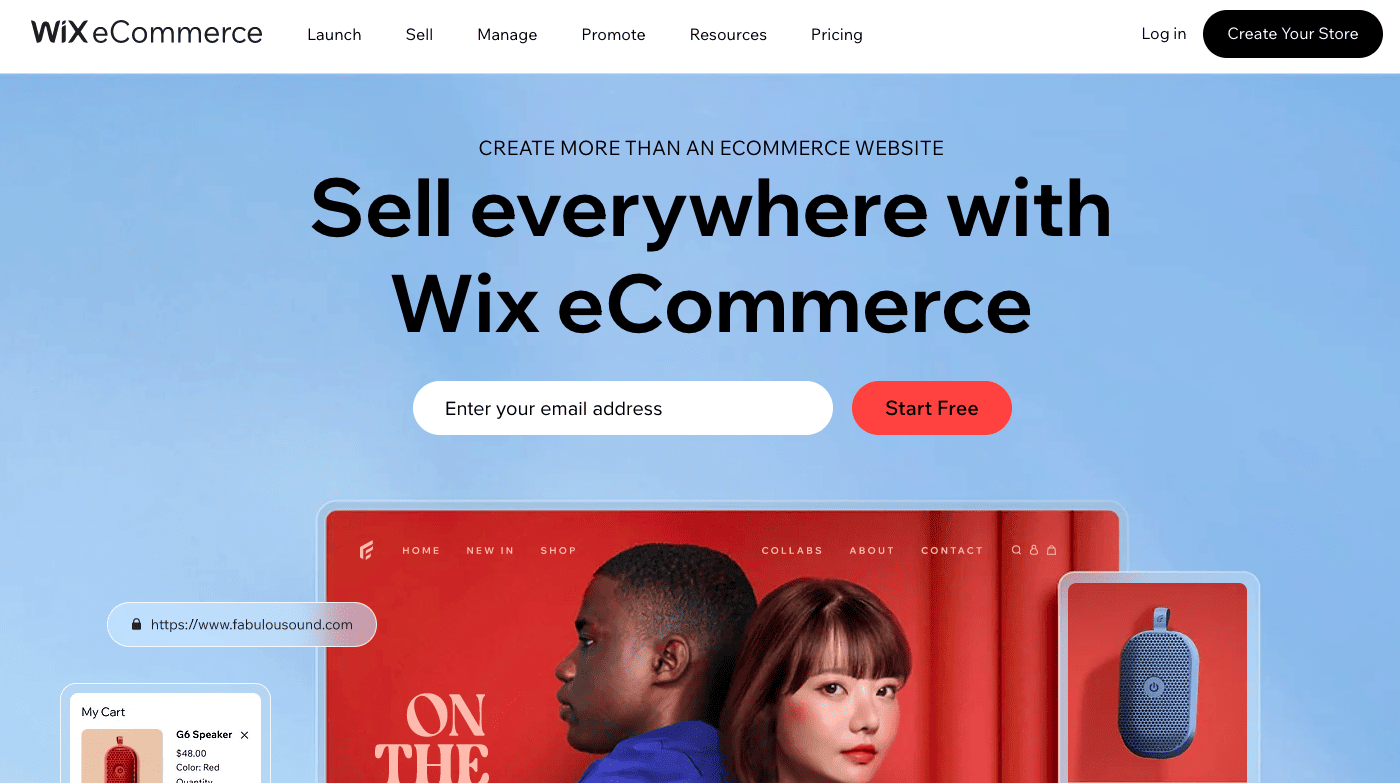
Wix is a great platform for beginners, with intuitive editing tools and an excellent selection of templates. The unlimited free trial is ideal for those who have never used a website builder before and might need a little more tinkering time before launching the site. Wix stores support product videos and Wix has an app market which allows you to add all kinds of functionality to your website.
If you want to learn more about using Wix for building your online store, check out our detailed analysis here. You can also try it for free here.
Shopify

We awarded Shopify our Best Ecommerce Solution badge for 2023. Shopify provides powerful tools to create an online store that is ready to scale. It offers tons of flexible templates and features. In order to add product videos, make sure you choose a Shopify theme which supports them. Shopify also has an excellent selection of apps that you can use to enhance your store.
Shopify is more expensive than other comparable options, so read our full review to make sure it’s worth it for your business. Compare Shopify to Etsy here. You can also trial Shopify for free here.
Squarespace
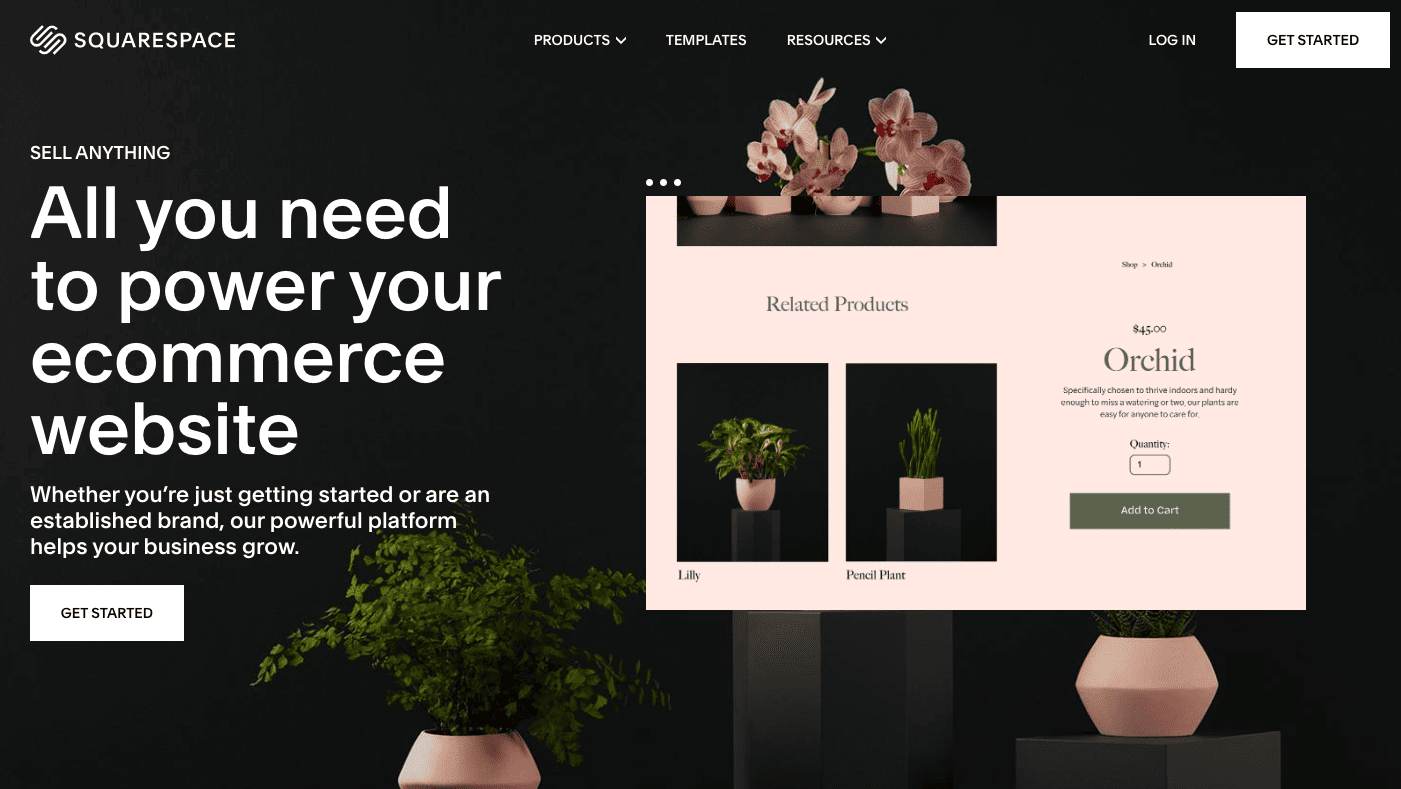
Squarespace is a good option for sellers who offer digital products or subscriptions, and also boasts excellent blogging features. We especially like Squarespace’s versatile product descriptions which can include video and Instagram feeds. One drawback is that it doesn’t provide as many shipping or fulfillment options as competitors like Shopify. So if you’re selling physical products, start with the 14-day free trial to make sure the available options will work for your business.
Some ecommerce plans include transaction fees, so be sure to read our full Squarespace review to decide if Squarespace is the best option for you. You can also test it out for free.
WooCommerce

WooCommerce is a flexible and scalable ecommerce solution that plugs into the WordPress platform. However, we don’t recommend it for complete beginners. (Unless you’re willing to spend a lot of time learning the technical side of website building!) To build an online store with WooCommerce, you will first need to select a hosting provider, and then add features with themes and plugins. WooCommerce does not provide customer support, so if you need help you will have to contact the theme or plugin developers directly.
Although not the most beginner-friendly option, WooCommerce does have powerful features and gives you complete control over your store’s design. You can read our WooCommerce review here to help you weigh up the pros and cons.
Pro Tip: One of the benefits of Pattern by Etsy is not having to manually recreate product listings. Fortunately, Wix, Shopify, Squarespace, and WooCommerce all allow you to do this by importing product data with a CSV file. Simply download your listing information from Etsy, then upload it to your chosen website builder. All your product data (like photos, descriptions, pricing, etc.) will be imported, saving you many hours of work.
To sum up, here’s a side-by-side comparison of the website builders we’ve discussed.
| Pattern | Wix | Shopify | Squarespace | WooCommerce | |
|---|---|---|---|---|---|
| Price | $15/month | Starting at $29 / month (billed annually) | Starting at $39 / month (billed annually) | Starting at $23 / month + 3% transaction fee | Starting at $13.99 / month with Bluehost |
| Ease of Use | |||||
| Choice and Flexibility of Templates | |||||
| Product Presentation |
Final Recommendations: Love Etsy, Leave Pattern.
My final recommendations come in the form of a cautionary tale.
In August 2014, Etsy launched a new feature called Etsy Wholesale. I enthusiastically joined this platform and invested many hours into building my Etsy Wholesale shop to sell in bulk to qualified retailers.
Fast forward to 2018, and Etsy abruptly announced that Etsy Wholesale would be closing. Sellers were given just a few months to save our data and make other arrangements with our wholesale clients. Etsy Wholesale was simply not profitable enough for Etsy to maintain. I wished that I had built a wholesale website for my business outside the Etsy platform.
It’s not inconceivable that Etsy could eventually decide to close Pattern. Pattern was launched in 2017 and has scarcely received an update since then. (Not even to add product videos!) Etsy’s focus seems to be on its marketplace, not Pattern.
Because of this, I don’t recommend that Etsy sellers use Pattern to build their own website. If you’re going to invest the time and money into building an online shop, it’s best to do so with a platform that will provide regular updates and improvements. In other words, stick with a website builder whose main business is, well, building websites.
We’ve reviewed tons of great website builders here on Tooltester, and when you’re ready to build your online store we’ve got all kinds of guides to help you along. Good luck!
THE BEHIND THE SCENES OF THIS BLOG
This article has been written and researched following a precise methodology.
Our methodology